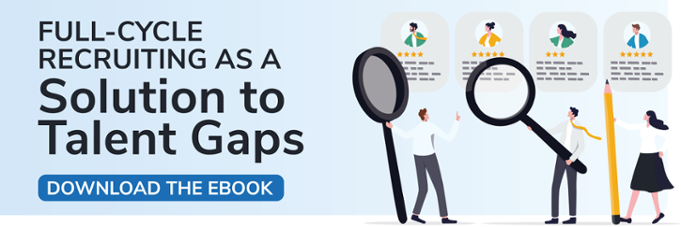Topic Outsourcing HR / PEO,
11 Effective Ways to Improve Your Talent Acquisition Process

July 11, 2023 | By Questco Companies

The world of talent acquisition is complex and ever-evolving. Getting it right is crucial for the success of your organization.
With terms such as "candidate pool," "employer branding," and "recruitment marketing" flying around, it's easy to get lost in the jargon. But at its core, talent acquisition is about creating value. That’s one thing that an astounding 77% of talent leaders agree upon according to a 2023 LinkedIn study. These leaders say their talent acquisition strategies are more about total value creation for the company than about achieving cost savings, a sentiment that's shot up by 32 points from just 45% the previous year.
The fact is, talent acquisition isn't a one-size-fits-all strategy, and it's certainly not as simple as just filling a vacancy. It's a multifaceted process that requires a deep understanding of not just recruitment, but also the broader talent landscape. Let's delve deeper into this topic by exploring how talent acquisition compares with recruitment. Then, we'll discuss the eleven most effective ways you can improve your talent acquisition process.
Talent Acquisition vs. Recruitment
Talent acquisition is a strategic approach to identifying, attracting, and onboarding top talent to efficiently and effectively meet dynamic business needs. This function goes beyond merely filling open positions. It involves mapping out long-term talent needs, understanding the talent landscape, and implementing strategies to attract and engage potential candidates.
Contrast this with "recruitment." Often used interchangeably with talent acquisition, recruitment is actually a subset of the talent acquisition process. It is the act of attracting, shortlisting, selecting, and hiring suitable candidates for jobs (either permanent or temporary) within an organization. Recruitment generally focuses on fulfilling the company's immediate vacancies.
Understanding the distinction between these two terms is critical. While recruitment can be reactive, filling vacancies as they arise, talent acquisition is a proactive, strategic process. It ensures that businesses are prepared to fill critical roles without experiencing detrimental gaps in operations.
Having these definitions in mind sets the stage for what's to come. Below are eleven powerful strategies to take your talent acquisition efforts to the next level.
1. Leverage Integrated HR Technology
The digital age has swept across all sectors, and human resources hasn't been left behind. The right technology can streamline your talent acquisition process, making it more efficient and effective.
Consider just one aspect of HR technology: the Applicant Tracking System, commonly known as ATS. This tool does more than just track applicants; it enables relationship-building and enhancing the candidate experience. It automates the routine, letting you focus on the job's more nuanced, human aspects.
But an ATS is just the beginning.
The right HR technology will consolidate multiple platforms, streamlining HR processes while tracking all relevant KPIs. Such integrated software is available to companies that partner with a professional employer organization (PEO).
Making technology your ally isn't a mere suggestion for today's talent acquisition professionals. It's becoming an inevitable necessity. But, as we move on to the next section, you'll see that technology isn't the only key to attracting top-tier talent. There's something equally important: your employer brand.
2. Strengthen Employer Brand Management
As we inch further into 2023, the labor market is still recovering from various global upheavals, including the Great Resignation and the (now dwindling) signs of another recession. This makes it more crucial than ever for companies to rethink their talent acquisition and retention strategies.
One effective way to navigate these rough waters is by focusing on employer brand management, specifically through engagement surveys. These handy tools collect data on what makes your organization an attractive employer, and the results can be used to boost your employer brand and its communication.
If you can incorporate that feedback effectively, you can become an employer of choice.
3. Focus on Candidate Experience
In this competitive, candidate-driven job market, offering a positive candidate experience is not just beneficial—it's essential. Tailoring a candidate-centric experience can lead to impressive outcomes and help you stand out to high-caliber talent.
However, crafting an experience that suits everyone can be a real challenge due to candidates' diverse needs and preferences. Understanding the hiring experience that candidates prefer can make a substantial difference. Providing an exceptional candidate experience at every step of the recruitment process will have a tangible impact on your bottom line while making your job offer more appealing than your competitors'.
Once you’ve perfected the candidate experience, it’s time to focus on developing a talent pipeline.
4. Develop a Talent Pipeline
Picture this: an all-star employee unexpectedly leaves your organization. Rather than scrambling to fill the gap, what if you had a line-up of top-notch candidates ready to step in? That's the power of a well-developed talent pipeline, also called a talent pool.
Developing a talent pipeline is about proactive recruitment. It's not just about filling an open position today, but planning for future vacancies and maintaining relationships with potential candidates. This strategy ensures you're not caught off guard by sudden departures or rapid company growth.
Nurturing relationships with high-potential candidates can reduce time-to-hire and increase the quality of your hires. By keeping the lines of communication open, you're maintaining a connection with potential future employees and allowing them to get a feel for your company's culture and values. This familiarity can make the onboarding process smoother when a position opens up.
But even as we focus on the future, it's crucial not to forget the present. A critical element of talent acquisition is ensuring you are offering competitive compensation.

5. Offer Competitive Compensation Packages
Did you know that over half of employees (56%) would leave their job for a higher-paying position?
That's a startling statistic, but one that underscores the importance of competitive compensation in talent acquisition and retention.
Competitive compensation isn't just about base salary. It includes the entire benefits package - health insurance, retirement contributions, bonuses, and more. This holistic approach to compensation can make your organization more attractive to top talent.
It's also important to remember that competitive doesn't necessarily mean the highest. Instead, it's about offering a package that aligns with the market, the job role, and the individual's skills and experience.
Remember, your employees are your most valuable resource. Ensuring they're fairly compensated is a vital part of retaining top talent. But what if you could tap into the networks of these satisfied employees to find more like them?
6. Implement an Employee Referral Program
One of the most underrated strategies in talent acquisition is implementing an employee referral program.
When your employees become your advocates, they can help expedite the hiring process, often resulting in high-quality candidates. Your workforce is connected to a broader network of potential candidates who may be just the talent you're seeking. By incentivizing your team to refer these candidates, you're utilizing a cost-effective and efficient strategy that can quickly widen your talent pool.
Plus, referred candidates are known to perform better, require less training, and stay longer with the company, all of which can result in cost and time savings for your organization. Employee referral programs also contribute to increased employee engagement, as your team takes an active role in shaping your company's future.
In the end, employee referral programs are an effective tool for talent acquisition, one that could be the secret ingredient your recruitment process is missing. After all, who knows better than your own employees about who would be a good fit for your organization?
7. Consider Recruitment Marketing
The recruitment landscape is undergoing a digital revolution, and it's called recruitment marketing. Like traditional marketing, this approach aims to attract high-quality candidates by promoting your company as the ideal employer.
From creating compelling content and building brand awareness to engaging and converting potential candidates, recruitment marketing is a multifaceted strategy that combines several elements to drive your talent acquisition process.
A successful recruitment marketing strategy can include a variety of tactics, such as sponsored articles, infographics, and digital advertising to reach potential candidates. Lead generation solutions can help connect with candidates actively researching job opportunities like yours, ensuring a consistent flow of high-quality applicants.
With recruitment marketing, you're not just posting a job vacancy - you're telling a story, showcasing your company culture, and positioning your organization as a great place to work. It's a powerful strategy that can significantly enhance your talent acquisition process, giving you an edge in the job market.
8. Engage Passive Candidates
The best candidates may not be individuals currently looking for a new job. Many talented workers fall into the category of "passive candidates." Passive candidates are not actively job-hunting but might be open to new opportunities if approached correctly.
Engaging passive candidates isn't about pestering them with unsolicited messages. Instead, it's about building genuine relationships and demonstrating that your company could provide them with something their current role doesn't.
Still, don't forget about personalization. Each message should be tailored to show an understanding of the candidate's skills, experiences, and career aspirations. The goal is to spark their interest and make them consider the possibility of a professional change.
9. Encourage Internal Mobility
Promoting from within isn't just about filling a vacant position; it's about investing in your organization's future. Companies that champion internal mobility often find their employees more engaged and likely to stay with the company long-term.
Encouraging internal mobility serves multiple purposes. It helps retain top talent, fosters employee engagement, and reinforces a culture of growth and opportunity. Moreover, it sends a strong message to all employees that their career development is a priority for the organization.
There are several ways to promote internal mobility. Establishing mentorship programs, providing continuous training and development opportunities, and having transparent succession planning are just a few examples.
As we delve further into innovative strategies for improving talent acquisition, the next one might sound a bit unconventional, but it's gaining traction: the use of gamification in the recruitment process.
10. Gamify Talent Acquisition
Gamification has emerged as a promising tool to engage potential candidates and enhance recruitment. Gamification involves the integration of game mechanics into non-game environments, such as recruitment processes, to make them more interactive and engaging. By leveraging the universal appeal of games, companies can make the recruitment process more engaging, efficient, and effective.
By gamifying assessments, companies can evaluate candidates' skills in a less stressful, more immersive environment. According to a study by the University of Colorado, gamification results in 14% higher scores on skill-based knowledge assessments and 11% higher scores on factual knowledge tests.
Additionally, gamification can also boost employer branding. A Zippia survey found that 78% of surveyed people said that gamification in recruiting would make a company or position more desirable to them.
11. Outsource Certain Recruitment Tasks
Imagine a squad of seasoned professionals carefully curating your talent pool, honing your hiring practices, and orchestrating your HR operations. This isn't a dream but a potential reality when you embrace HR outsourcing.
Recruitment Process Outsourcing (RPO), a subset of HR outsourcing, involves transferring specific HR responsibilities to external specialists. It's like having a fully-fledged HR department without the overheads and complexities typically associated with it.
A Professional Employer Organization (PEO) is a prime example of such an HR outsourcing solution, offering a multitude of services to businesses. PEOs can be instrumental in talent acquisition, bringing both proficiency and efficiency to the table.
One of the numerous advantages of PEOs is the substantial cost savings they can provide.
PEOs have the capacity to pool their clients' employees to secure health insurance, retirement plans, and other employee benefits at discounted rates, passing these substantial savings onto their clients.
Similarly, in the fiercely competitive world of talent acquisition, PEOs can be a potent tool. These organizations house recruitment specialists who know how to draw in top-tier talent. They also provide access to savvy, web-based technology, allowing you to handle your entire recruiting process online. This results in more accurate job descriptions, more qualified candidates, and a more streamlined screening process.
Talent Acquisition Never Ends
Don’t underestimate the power of a fine-tuned talent acquisition process. It's about more than just filling vacancies. It's about strategically sourcing, assessing, and hiring candidates who will add value and drive growth for the organization. With the right approach and tools, you can build a team ready to take on the future.
Just remember, the talent acquisition journey doesn't end once a candidate has been hired. Investing in their growth and development is essential while fostering a culture that encourages internal mobility. After all, today's new hire could be tomorrow's leader.
Ultimately, your talent acquisition process should truly reflect your organization's culture, values, and mission. You aren’t looking for talent, you’re looking for the right talent. It's time to step back, reassess your talent acquisition strategies, and ask yourself: Are you doing everything you can to attract and retain the best?




